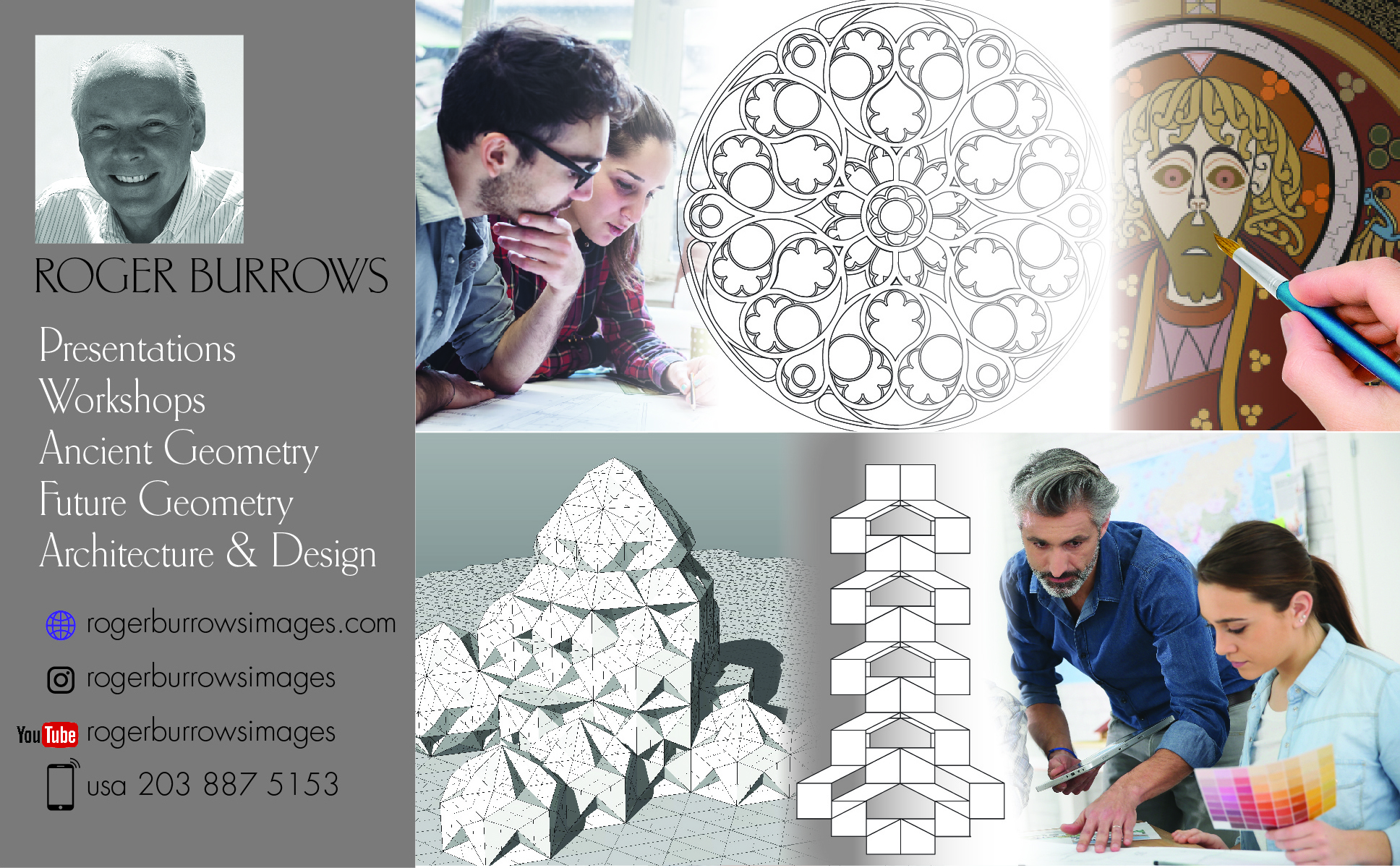WORKSHOPS

Workshops to compliment presentations, published papers and “3D Thinking in Design and Architecture from Antiquity to the Future,” published by Thames and Hudson: ANCIENT DESIGN METHODS; ISLAMIC DESIGN METHODS; CELTIC DESIGN METHODS; LABYRINTH DESIGN METHODS; SHAPE-CHANGERS; GOLDEN-RATIO 3D ARCHITECTURE. Examples: http://rogerburrowsimages.com/think-3d/supplement/
- ANCIENT DESIGN METHODS: Participants will be given sets of worksheets that break down surface designs from ancient cultures – Indus Valley, Greece, Medieval Europe, Egypt, China, Celtic Europe, Abbasid Islam, Pre-Columbian Americas. Each worksheet set is supplied in three levels (a) ‘base’ grids. (b) ‘design-grids.’ (c) examples of ancient designs extracted from the ‘design grids.’ (all supplied as line drawings). Applications can be rendered in any medium and in color or as line renderings – on paper, card, tile, canvas, wood, glass, plaster… A theme of the class is that ancient designs communicate on many levels; structurally, symbolically, perceptually, through number-word associations and, in some cases, through movement and dance. The workshop will include short introductory multi-media presentations. 1 to 3 day workshop. $150 per day.
- SIX ABBASID ISLAMIC DESIGN METHODS: The six design methodologies are the primary methodologies developed during the Abbasid periods in Bagdad and Cairo 750-1258CE and 1261-1517CE with applications in tile form on walls, on windows, on domes, on garments, on furniture, etc. (i) Tessellating Grids (ii) Tessellating Polygon Subdivions (iii) Rays (iv) Close-Packing Circles (v) nesting Polygons (vi) Modular Tiles. Worksheets will be given in sets supplied in three levels (a) ‘base’ grids. (b) ‘design-grids.’ (c) examples of Abbasid designs extracted from the ‘design grids.’ (all supplied as line drawings). Applications can be rendered in any medium and in color or as line renderings – on paper, card, tile, canvas, wood, glass, plaster… A theme of the class is that ancient designs communicate on many levels; structurally, symbolically, perceptually, through number-word associations and, in some cases, through movement and dance. The workshop will include short introductory multi-media presentations. 1 to 3 day workshop. $150 per day.
- CELTIC DESIGN METHODS: These are design methodologies that have their origins in the Neolithic period evolving through to medieval (European) periods. Design types include (i) grids (ii) knots (iii) touching circles (iv) spirals (v) symbols (vi) figurative – human, animal and fantastic creatures. Worksheets will be given in sets supplied in three levels (a) ‘base’ grids. (b) ‘design-grids.’ (c) examples of ancient designs extracted from the ‘design grids.’ (all supplied as line drawings). Applications can be rendered in any medium and in color or as line renderings – on paper, card, tile, canvas, wood, glass, plaster… A theme of the class is that ancient designs communicate on many levels; structurally, symbolically, perceptually, through number-word associations and, in some cases, through movement and dance. The workshop will include short introductory multi-media presentations. 1 to 3 day workshop. $150 per day.
- LABYRINTH DESIGN METHODS: There are three primary labyrinth design methods (i) The ‘Key’ method. (ii) The Grid Method. (iii) The ‘Switch’ method. The ‘Key’ method dates back to Neolithic times and can be seen to have been applied around the world. The ‘Grid Method’ was originally developed in Ancient Rome, possibly before that, and then developed all the way to current times. The ‘Switch’ method appears to have been developed in medieval Europe with many applications in Gothic cathedrals. Worksheets and interactives will be supplied where worksheets will be given in sets supplied in three levels (a) ‘base’ grids. (b) ‘design-grids.’ (c) examples of ancient designs extracted from the ‘design grids.’ (all supplied as line drawings). Applications can be rendered in any medium and in color or as line renderings – on paper, card, tile, canvas, wood, glass, plaster… A theme of the class is that ancient designs communicate on many levels; structurally, symbolically, perceptually, through number-word associations and, in some cases, through movement and dance. The workshop will include short introductory multi-media presentations. Objective is that participants will be able to re-create ancient labyrinth designs but also create new labyrinths and variations. 1 to 3 day workshop. $150 per day.
- SHAPE-CHANGERS: Participants will be be given templates and materials for creating shape-changing polyhedra of different types: (a) modular – where shape-changer modules can interconnect to create ‘infinite’ shape-shape changing polyhedra some of which always transform within 3D space and (b) others shape-change to 2D positions. Various materials are supplied both card and plastic. Objective is to develop shape-changing concepts for 3D architecture, for surfaces, for robotics, vehicles, solar panels and more. Applications can be ‘macro,’ ‘micro,’ or nano. The workshop will include short introductory multi-media presentations with discussion regarding new materials and constructional technologies. 1 to 3 day workshop. $150 per day.
- GOLDEN RATIO 3D ARCHITECTURE: Participants can work digitally using 3D software such as Rhino or Solidworks – but also with physical mediums; plastic, wood or card. The basic logic is based on a ‘Golden Ratio’ 3D close-packing arrangement of spheres that fills 3D space. Connecting sphere centers creates 3D lattices from which an infinite number of architectural forms can be extracted. All extracted forms by the nature of the 3D ‘close-packing’ spheres will be in “Golden Ratio” proportion and position. Extracted forms can be symmetrical or non-symmetrical – and also can be connected by extracted and proportioned forms (corridors, antechambers, etc). The workshop will include short introductory multi-media presentations with discussion regarding new materials and constructional technologies. 1 to 3 day workshop. $150 per day.

